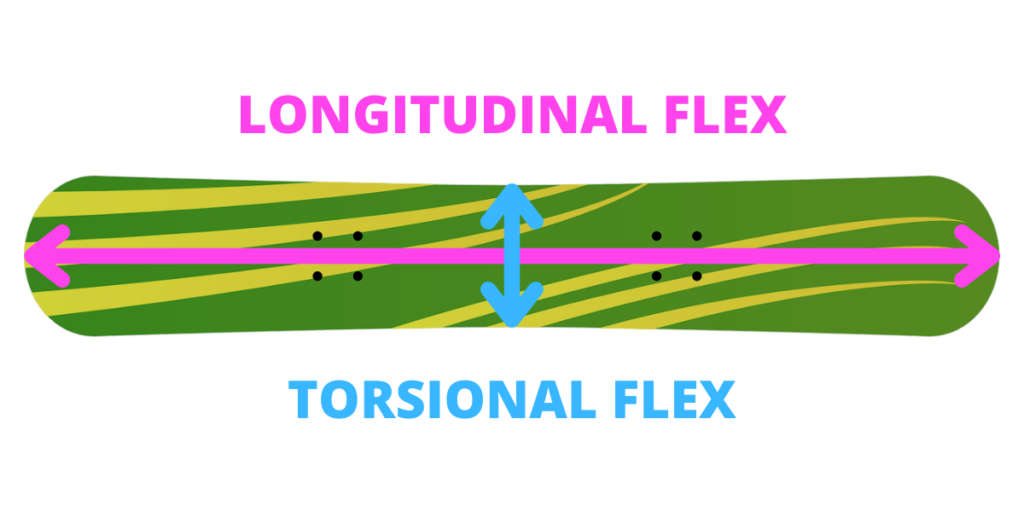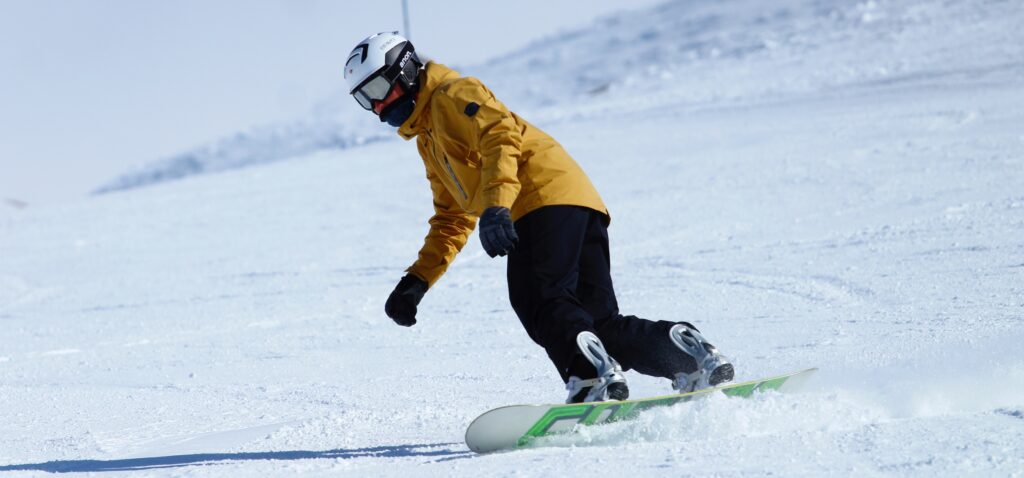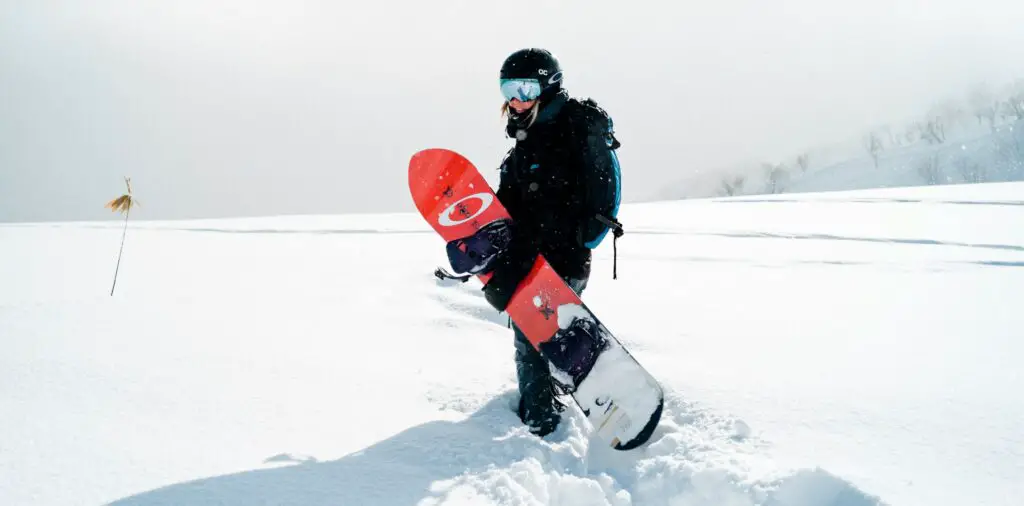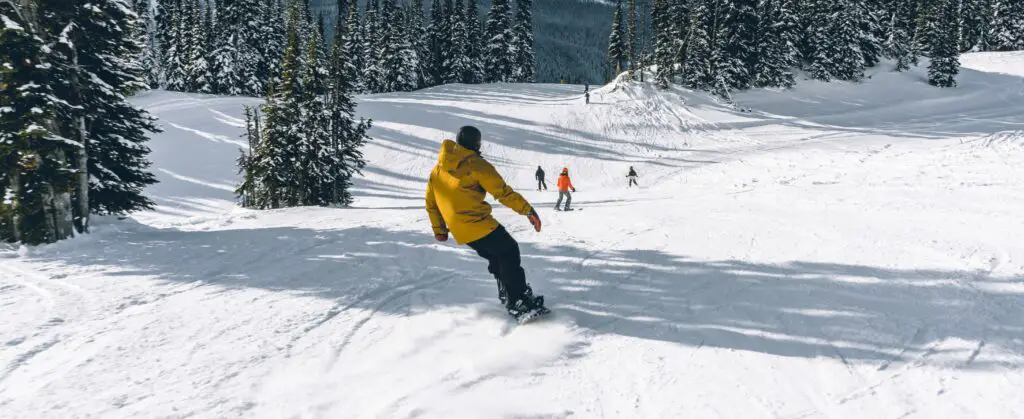The flexibility of a snowboard affects how it feels, performs and how suitable it is for different riders and styles of snowboarding. In this article, I’ll explain why snowboard stiffness matters so much and the pros and cons of soft and stiff snowboards.
Snowboard Flex Explained
There are two types of flex to consider:
- Longitudinal flex: refers to the flexibility of the snowboard from the tip to the tail
- Torsional flex: refers to the flexibility of the snowboard from one edge to the other
The longitudinal flexibility of a snowboard affects its stability, speed and responsiveness. The torsional flexibility of a snowboard affects how quickly the board transfer from edge to edge and how much edge hold it has. Boards with more torsional flex have more edge hold and transition more quickly.

Most manufacturers give their snowboards a flex rating out of 10. This flex rating refers to the longitudinal flexibility. The higher the flex rating, the stiffer the snowboard is lengthways.
| Flex Rating | Flexibility |
| 1-2 | Soft |
| 2-3 | Soft-Moderate |
| 5-6 | Moderate |
| 7-8 | Moderate-Stiff |
| 9-10 | Stiff |
This flex rating makes it easier for buyers to determine the relative flexibility of the board. However, keep in mind that there is no universal snowboard flex rating system. Hence, a snowboard with a flex rating of 5 may actually be stiffer or softer than a snowboard which also has a flex rating of 6 from another brand.
The scale is different for each manufacturer, however it can still be used to compare relative stiffness within the same brand, or give you a rough idea of the flex when comparing snowboards from multiple brands.
Why are Some Snowboards Stiffer?
The flexibility of a snowboard is affected by its thickness, width, length and the materials used. Some snowboards have a soft foam core which makes them more flexible, whereas most snowboards have a wooden core which makes them stiffer.
Some manufactures add carbon poles towards the edges of the snowboard which makes them stiffer but without increasing the weight.

How Does Snowboard Flex Affect Performance?
- Speed and Stability
- Control
- Edge hold
- Landing Jumps
Speed and Stability
Stiffer snowboards feel more stable at high speeds and hence are recommended for high performance riding. Softer snowboards can feel more unstable at higher speeds as there is more flex in the board.
Control and Turning
Softer snowboards feel easier to control and beginners will find them easier to turn compared to stiffer boards. This is because the energy from the rider is not transferred as quickly to the board making them feel more forgiving.
Edge Hold
Stiffer snowboards provide more edge hold compared to softer snowboards. This means that stiffer snowboards provide more grip which is particularly useful for freeriding.
Landing Jumps
A softer snowboard is better for landing smaller jumps because it helps make it feel smooth. However, the opposite is true when considering bigger jumps.
A stiffer snowboard is better for landing bigger jumps because it helps to provide stability. A soft snowboard provides limited support when landing higher jumps and the risk of it breaking are greater.

Pros and Cons of Softer Snowboards
Advantages of Soft Snowboards:
- More forgiving
- Easier to control and turn
- Good for beginners
- Small jumps feel comfortable
- Recommended for park/ free-style
Disadvantages of Soft Snowboards:
- Not much pop
- Feels sloppy at high speeds
- Lack of stability
- Not good for larger jumps
- Poor edge hold
Pros and Cons of Stiffer Snowboards
Advantages of Stiffer Snowboards:
- Better for larger jumps
- Good stability
- Better for aggressive riding
- Great for carving (improved edge hold)
- Recommended for free-riding
Disadvantages of Stiffer Snowboards:
- Not recommended for beginners
- Less suitable for park/ free-style
- Less forgiving and harder to control
- Feels more bumpy
- Requires more effort (leg-work)
Types of Snowboard and Flexibility
Now let’s take a look at the different snowboard flex ratings and how suitable they are for different types of snowboarding.
| Type of Snowboard | Typical Flex Rating |
| Freestyle/ Park | <4 |
| All-Mountain | 4-7 |
| Freeride | >7 |
Freestyle
Freestyle/ park boards are typically softer and have a lower flex rating on the scale. In general, most freestyle/ park snowboards have a flex rating between 1-4.
Softer boards work best for freestyle snowboarding because they make butters and presses easier and make landing small jumps more comfortable. The increased flexibility makes the board easier to manipulate, turn and control.
Free-Riding
Free-riding is more aggressive compared to freestyle/ park snowboarding and hence a stiffer board is required. Most freeride snowboards have a flex rating of at least 7/10.
The extra stiffness helps to increase stability at high speeds, improve edge hold and makes landing larger jumps easier.
All-Mountain
All-mountain snowboards typically have a moderate flex rating which is usually between 4 and 7 out of 10. This makes them versatile so they can be used for both free-style and free-riding.
Stiffer all-mountain boards will be better for riders who want the option to do some park/ freestyle but primarily stick to freeriding. Conversely, softer all-mountain boards are best for riders who want to do mostly freestyle but a little bit of freeriding as well.
Check out this article comparing all-mountain and freestyle snowboards to learn more about their differences.
Twin vs Directional Snowboards
The flexibility of a snowboard often varies along its length with directional snowboards. Usually the snowboard is stiffer at the tail end and more flexible at the nose. The extra stiffness at the tail helps to improve edge hold, whereas the softness at the nose helps the board to float in powder.
Twin-tip snowboards are designed to ride the same backwards and forwards because they are symmetrical. These snowboards have the same level of stiffness at the nose and tail and are also known as “twin-flex” boards.

Ideal Snowboard Stiffness?
Okay so we’ve been through a lot in this article and I wanted to help give you a more definitive answer as to which snowboard flex rating will be most suitable for you.
The ideal flex rating for your snowboard will depend on the following things:
- The type of snowboarding you’re doing
- Your height and weight
- Your ability level
As we discussed earlier, stiffer boards work best for free-riding, whereas softer board work best for park/ freestyle. If you’re mixing up the type of snowboarding you’re doing then you’ll need to go with an all-mountain board which will have a moderate-soft, moderate or moderate-hard flex rating.
Heavier riders require a stiffer snowboard to give them more support compared to lighter riders which will find a softer snowboard more suitable. If you are above average in terms of your weight according to your height, then you’ll need a slightly stiffer board by 1-2 points on the flex scale within the range for the type of snowboarding you’re doing.
For example, if you are an all-mountain rider with a lower weight for your height then you’ll probably be best with a flex rating of 4-5 rather than a flex rating of 6-7 which would suit a heavier rider.
Finally, we need to talk about ability level.
Softer snowboards are more forgiving and easier to control so are favoured by beginners. Stiffer boards feel more stable at high speeds so are better for more advanced, aggressive riders.
Hence, if you are looking for an all-mountain board and are a complete beginner then it’s best to stick to a flex rating of 4-5 rather than going for a much stiffer board.
Here are some more articles you might find useful:

